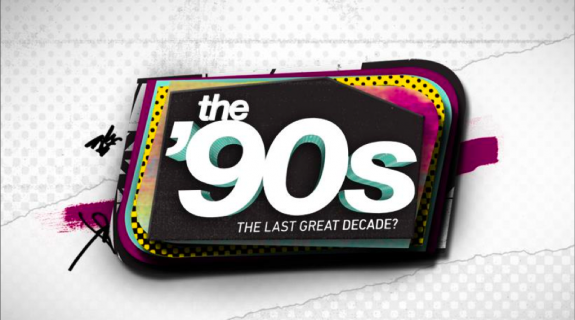Condensing an entire decade into one six-hour miniseries is one thing; promoting it across 171 countries and 45 different languages is quite another.
But that’s been the task faced by Emanuele Madeddu, VP of consumer marketing for National Geographic Channels International, and Andy Baker, SVP and group creative director at National Geographic Channels, as they have worked to prepare for this weekend’s July 6 US premiere of the network’s “The ‘90s: The Last Great Decade?” followed by an international release in more than 440 million households worldwide.
As it did for last year’s “The ‘80s: The Decade That Made Us,” Baker’s stateside team’s collaboration with Madeddu’s global team has resulted in a planet-sweeping marketing effort for “The ‘90s.” Banking heavily on the nostalgia factor of a decade that gave us everything from the Monica Lewinsky scandal to Pogs, the campaign offers a romp across on-air, digital and outdoor elements packed with iconic personalities, props, pop songs and plenty of trivia.
In the outdoor space, vacationers in The Hamptons and on Jersey Shore have been treated to free rides in “The ‘90s”-branded cars outfitted with iPads displaying show content, and New Yorkers have encountered bus shelter displays featuring such ‘90s memorabilia as flannel shirts and Vanilla Ice paraphernalia (the rapper also performed at a branded ‘90s-themed party in the seaside town of Montauk). Outdoor key art blanketing busses and taxis, Baker said, features “that sort of collage idea of pictures of celebrities from newspapers and magazines that you ripped out and made into that iconic-looking ‘90s feel.”

In light of the ongoing trivia boom in the US, Baker said NGC’s consumer marketing team had great fun finding areas to engage people with questions about their favorite decade’s pop culture and history. A robust website, Rulethe90s.com, offers a trivia challenge replete with prizes, a leader board and social sharing. Meanwhile, the week leading up to the US premiere found pop-up trivia game show sets showing up in New York and Washington D.C. and further executions in media-sponsored bar trivia nights at 203 local markets.
“The ‘90s” is all about “things you think you remember that put a smile on your face or things that you didn’t know, and trivia’s a big part of that,” Baker said. “It’s another way to reach a bigger audience in a fun, interactive way. It’s not just like ‘this is a show and we’re going to tell you about [the ‘90s]. You become a part of it too, because you’re remembering along the way and you want to get a deeper dive into the content and that’s where the show steps in.”
On the international side, Madeddu said he encourages local regions’ marketing teams to stage their own trivia executions and taxi rides, but also “challenges them to come up with their own stories, their own local activations that somehow resonate even better in their market. This is what makes me happy at the end of every campaign. We can send out the strategy, send out the assets, and then inspire them to do better than us. This is what we ask from our teams outside the US.”
That inspiration by different nations’ teams will certainly involve heavy usage and interpretation of a clever launch spot by The Corner, seen at the top of this story. As they did previously with their Rubik’s Cube-centered launch spot for “The ‘80s,” the London agency (and this year’s Global Agency of the Year winner at the PromaxBDA Awards) displayed its ability to create concepts both delightful to behold and imminently practical. Adopting a ‘90s-era MS Windows-style graphical scheme, the promo immediately grabs the viewer’s attention via what is perhaps the single most important innovation of the decade in question – the double-click. From there, it’s a rapid :60 pixilated digital romp through memorable moments, including brilliant pairings of historic events such as the O.J. Simpson fiasco with beloved computer games such as “Sim City” and “Doom.”
The promo also works nicely as a thematic comment on the decade where computers connected us in ways that would forever change us. It’s hard to imagine a better combination of form and function, which, said Madeddu, was especially important in this case because of “the specific needs for each of the markets. The goal for us every time we find a creative device is to make sure this can not only work internationally but can also be easily [replicated visually]. There are special hours being created for ‘The ‘90s’ in some markets so it’s important for us that some of the content can be swapped in or out for the entire campaign in a very seamless way without losing the creative power. The idea of connecting everything through that little device was a clever solution.”
“This was a really fun one for us because we were sharing assets across international and the US,” Baker said. “That’s what makes this brand really special for us. It’s like we’re doubling the creative power of the campaign. It’s cool to see how it can extend across the whole global landscape.”
Tags:













































__twocolumncontent.jpg)










